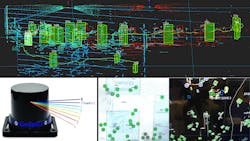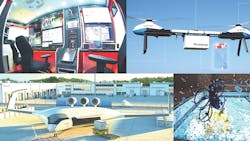As the ISC West event came to end this past Friday, the talk of the show was as much about renewed acquaintances and reigniting business relationships as was the new and emerging technologies. Here we spotlight two of the more advanced security solutions we covered in Las Vegas.
i-Pro
Formally Panasonic i-Pro Sensing Solutions Co., Ltd., i-Pro presented one of the most comprehensive ranges of IP video surveillance, access control, forensic video search criteria, and business intelligence solutions. Specifically, i-Pro had extensive demonstrations of AI-driven analytics, including facial recognition analysis, vehicle search, privacy guard, and non-mask detection, using a wide range of parameters relating to color, size, time, object category and object characteristics.
Complementing the product lines were partner video management systems and services like Genetec Stratocast, Video Insight, Centralized Vision Remote Guard, and Unified Digital Evidence management software.Ambarella refers to ODMs and Tier-1 suppliers as customers (direct integration of processor to functional assembly) and OEMs as end customers (direct integration of functional assembly to system solution – the camera). i-Pro is a significant OEM to Ambarella, as their solutions include the 25MP WV-S8573LG and 33MP WV-S8574L - multi-sensor camera designs based on their ability to process multiple high-resolution streams concurrently with AI processing engines. The thinnest multi-sensor camera system in the IP camera market, these are equipped with four sensors per camera capable of independent operation for 360-degree viewing with minimal blind spots and color imaging in just 0.05 lux, extremely low-light conditions. “Legacy” multi-sensor IP cameras can often be seen in major airport baggage areas, protruding downward from ceilings by about a foot. The i-Pro packs four modular, removable, adjustable sensors in a package just 3.5-inches in height.
Ambarella CVflow AI vision processors have efficient neural network processing performance, stereovision support, excellent image quality and extremely low power, features prerequisite for multiple, complex algorithms in computer vision (CV). Although not directly published, the knowledgeable i-Pro booth staff discussed Tera Operations Per Second (TOPS), a measure of the processing capacity of the multi-sensor cameras, having a linear relationship with frames per second (FPS), number of streams at a given HD resolution.
IP cameras with “known” OEM System-on-Chip (SoC) CV processors like Ambarella or Hailo, having Convolutional Neural Networks (CNN) and Deep Neural Networks (DNN), are not easily compared to cameras with SoCs developed by the IP camera manufacturer itself. Some of the following became points of discussion at both the i-Pro and Hailo booths:
- A CV camera will have the capability of multiple CNNs of differing complexity, producing HD streams to multiple users. The i-Pro 33MP WV-S8574L CV multi-sensor camera has a maximum capacity of 24 users, whereas a typical multi-sensor with analytics will support a few algorithms simultaneously at a lower number of users.
- “Subjective image quality,” for various use cases, a.k.a. the “camera shootout” is next. On the image processing side, this camera includes Super Dynamic (120dB, range of 0 to 31), adaptive black stretch, backlight compensation (BLC), high light compensation (HLC), fog compensation, digital noise reduction, IR illuminator setting and Smart Coding for bandwidth optimization.
- TOPS, FPS, HD resolution, number of streams is the measure of the camera’s processing capacity for each user, then totaled, is an indicator of performance.
- When evaluating Edge AI Processor or Accelerator Performance, TOPS are not enough. Measure and compare neural processing power efficiency based on actual measured throughput and power for a specific task.
Also, in the i-Pro booth were Vehicle Capture Camera X5 series Model WV-X5550LT, Body-Worn Camera BWC4000, also equipped with low power, high neural network performance Ambarella CV processors, and targeted to the globally growing public safety market.
To give some perspective on the research behind the processing power that supports i-Pro’s surveillance and public safety markets, Ambarella cumulatively shipped more than 450K CV SoCs into the automotive market, which has extreme processing demands and expects to double annual growth in FY2022. In much the same way the i-Pro multi-sensor camera runs multiple deep neural network algorithms, a single Ambarella CV Processor supports the detection of objects in the driver’s path, object trajectory changes, Automatic Driver Assistance System (ADAS) and Driver Monitoring System (DMS) with eye-tracking, talking on the telephone and unsafe behavior. Examples of IP Camera Edge AI algorithms have been extensively covered by SIW at CES 2019 and CES 2022.
Also in the booth were new Models WV-U1542LA, WV-U1532LA 4MP, 2MP Varifocal Lens Outdoor Bullet Network Cameras with Intelligent Auto (iA), Super Dynamic (120dB maximum), ONVIF G / S / T profiles and IR LEDs. The corresponding Outdoor Box Network Cameras are Models WV-U1142A and WV-U1132A.
Quanergy
The SIW coverage of the Quanergy CES 2022 booth showcased their advanced 3D LiDAR modules receiving data from moving objects in a plan view, rotatable continuously 90 degrees to an elevation view. Most LiDAR modules receive reflected laser data from emitters positioned in a single dimension array. The Quanergy M8-1 Ultra 3D LiDAR Sensor is a compact and rugged sensor that operates reliably under challenging lighting and weather conditions including dust, mist, rain, and snow.Multiple laser beams and Time-of-Flight (TOF) range measurement result in 3D point clouds for spatial sensing. The M8 is the first cost-effective, high-definition TOF LiDAR sensor enabling ubiquitous use of smart sensing in harsh environments rotates this array so point clouds are resolved creating three-dimensional views equivalent to a trade exhibit booth, a residence, warehouse or multiple building complex, and rendered on their QORTEX perception software.
Quanergy’s QORTEX 2.1 LiDAR Perception Software Brings Real-Time PTZ Camera Control from multiple third-party OEMS Teledyne/FLIR, Axis Communications and Hanwha Techwin, and integration to VMS like Genetec and Milestone Systems, bringing automation to security, smart space, and smart city applications. Other features include:
- Real-time automation of PTZ camera control, point cloud recordings, and network actions reduces operating costs and improves security workforce efficiency.
- Over 30% improvement in object processing now enables simultaneous tracking of up to 300 objects.
- New auto-calibration capability simplifies installation.
LiDAR system feature comparison between LiDAR systems is challenging. Performance is even greater. The only straightforward comparison is for multiple layouts to be compared by the installation hours required for each component system. For example, Hexagon (Leica) Geosystems use a comprehensive system of multiple visible lights, panoramic, time of flight (ToF) and thermal imaging sensors, multi-dimensional software to test each component system versus every known threat at every known trajectory. LiDARs from third-party manufacturers like Ouster and Velodyne are supported by the Hexagon Accur8vision flagship software by Tacticaware.
Unless a solution architect, trained in sensor fusion, many LiDAR models and types and 3D visualization with attack vectors, as well as project cost and labor estimation, is brought into the project to compare disparate systems, the designs need to stand alone on their own capabilities.
Volatus
Volatus Aerospace: AVIDRONE: Looking like a small-scale Chinook Tandem Helicopter, the Avidrone system fully automates touch-and-go cargo delivery, long-range cruise flights, and precision surveillance missions. Designed for non-aviation operators, the Avidrone flight control system does all the flying by itself, maintaining safe and secure coordinated flight, developed specifically for Beyond-Visual-Line-Of-Sight (BVLOS) operations. With one-touch mission operation, UAS systems can be deployed on long-range missions without skilled pilots required. High-speed cruise flight and high-efficiency flight algorithms permit 2-pound to over 1,000-pound cargo to have touch-and-go automated package delivery, even via parachute. Fail-safes, geofencing, alternate landing zones, full simulation mission creation and complete telemetry logging and live mission feedback make this heavy hauling utility drone extremely versatile, especially in disaster areas.Volatus Aerospace: BRINC: With a door-pusher, glass breaker that works on tempered, automotive, and most residential glass, door opener, turtle mode that rights itself, airframe protected by carbon fiber, and a 10-hour perch time, the BRINC Lemur S is an excellent fit for indoor law enforcement, fire, hazmat and other first responder operations.
Volatus Aerospace: FIXAR: Housed in the so-named “007 case,” FIXAR 007 is a vertical takeoff and landing commercial drone with primary application in aerial photography, monitoring, UAV mapping and surveying, mining, oil and gas, energy, and agricultural sectors. Intuitive flight controls via ruggedized or normal tablet make working with the ground control station less complex than other multi-takeoff vehicles. With inertial orientation, FIXAR 007 can work stably under magnetic anomalies and in the event of satellite loss.
Volatus Aerospace: NATILUS Autonomous Aircraft: Aleksey Matyushev, born in Ukraine, is the CEO of Natilus, headquartered in San Francisco, producing the world’s first purposefully designed and manufactured autonomous aircraft for air freight transport. Recently, with supply chain issues wreaking havoc with everyone from silicon foundries to drug suppliers, advanced purchase commitments of more than $6 billion for the delivery of 440+ aircraft in pre-orders, from companies including major airlines and integrators like Volatus Aerospace.
“In parallel with the development of our family of autonomous aircraft, we are working closely with customers to increase the efficiency of air transportation and make it more competitive and safer than ocean shipping,” said CEO Aleksey Matyushev. “Today, there are only two ways to move cargo internationally: by air and by sea. The difference between the cost and time of these two modes of transportation is dramatic. Sea freight is currently 13 times less expensive than air freight; but 50 times slower in delivery, with staggering costs of shipment placement within the container and the potential to be stuck in a sea “queue” waiting for seaport and trucking manpower. Natilus intends to revolutionize the transport industry by providing the timeliness of air freight at an affordable cost reduction of 60%, making air cargo transportation substantially more competitive.”
The blended wing body has better lift-to-drag ratios than a conventional aircraft, resulting in improved fuel efficiency. Cargo is stored in a unique diamond pattern, making better use of the wing/body storage. Automated cargo load/unload solutions make it possible to serve truck transportation hubs directly, rather than add stepped complexity like the failing sea container shipment industry.
Nautilus offers greater efficiency and cost savings by providing fully autonomous aircraft and remote piloting for additional security, allowing for substantial scaling of operations for air freight. The family of cargo aircraft includes:
- 8-ton payload short-haul feeder UAV
- 60-ton payload medium/long-range UAV
- 100-ton payload long-range UAV
- 130-ton payload long-range UAV
Natilus has set out to reduce global air freight costs through the use of large autonomous drones and has moved quickly over the last couple of years to develop a sea-plane prototype to serve as a technology demonstrator.
The engineers at Natilus are now moving ahead at full steam to design a land-based freighter drone based on a blended-wing body. As the name suggests, a blended aircraft has no clear demarcation line between wings and fuselage. The advantages of this approach are efficient lift generation aided by the wide airfoil-shaped body, allowing the entire aircraft to generate lift. This means that a blended wing body has better lift-to-drag ratios than a conventional aircraft, resulting in improved fuel efficiency.
About the Author:
Steve Surfaro is Chairman of the Public Safety Working Group for the Security Industry Association (SIA) and has more than 30 years of security industry experience. He is a subject matter expert in smart cities and buildings, cybersecurity, forensic video, data science, command center design and first responder technologies. Follow him on Twitter, @stevesurf.
About the Author

Steve Surfaro
Steve Surfaro
Steve Surfaro is Chairman of the Public Safety Working Group for the Security Industry Association (SIA) and has more than 30 years of security industry experience. He is a subject matter expert in smart cities and buildings, cybersecurity, forensic video, data science, command center design and first responder technologies. Follow him on Twitter, @stevesurf.



